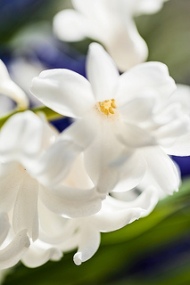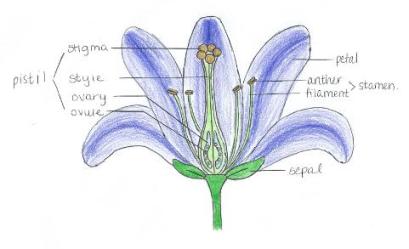
Reproduction
 Now,
for everyone's favorite topic: reproduction!
Now,
for everyone's favorite topic: reproduction!
Hyacinth produce nectar, a liquid rich in sugar that attracts
insects such as bees to the flower. As the insect feeds on the
nectar, it picks up pollen (microgametophytes, which eventually
produce the male gametes/sperm cells) from the anther of the stamen,
or the male reproductive parts, and spreads it to the
next flower it lands on. Once the insect lands on the next flower,
the pollen attaches to the stigma and travels down the style to the
ovary where it fertilizes the ovule. This fertilization process
marks the beginning of seed production, a necessary part of
reproduction in angiosperm. The picture below illustrates the parts
of a flower - the pistil includes the stigma, style, ovary, and
ovules and is the female part of the flower, whereas the stamen,
which includes the anther and the filament, is the male part of the
flower.

Hyacinth are "forced" to reproduce by those cultivating it by removing the new flower bulbs soon after they appear and planting those. While reproduction can occur in this manner naturally, the other method is far more likely.
Continue on to learn about the horticulture, or click here to return to the homepage.